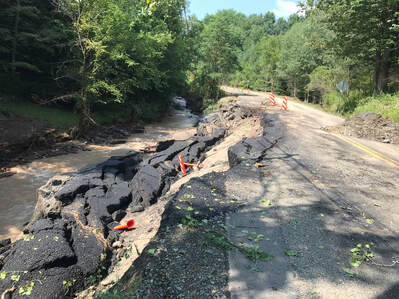CONSERVATION CORNER
A weekly blog for all things conservation
 By: Jonathan VanNoy, Natural Resource Specialist In 1972, the Environmental Protection Agency published regulations to reduce pollution through a new program; the National Pollutant Discharge Elimination System (NPDES, for short). This new program took aim at reducing pollutants to waters of the United States. In Pennsylvania, the NPDES program is administered by the State Department of Environmental Protection (DEP). In Bradford County, the Conservation District has a delegation agreement with DEP to administer the NPDES program at the County level. This allows people applying for earth disturbance permits in Bradford County to submit NPDES plans to the Conservation District for review and approval, speeding up the permit process. Today we are going to look at the NPDES program in Bradford County as it relates to earth disturbance and the resulting stormwater from construction activities. Stormwater, simply put, is runoff from precipitation, snowmelt, surface runoff and drainage. In PA, anyone who proposes more than 0.99 acres of earth disturbance for construction (with some exceptions) must apply for a NPDES permit prior to starting their project. This permit is composed of two distinct parts: An Erosion and Sediment (E&S) Control Plan and a Post Construction Stormwater Management (PCSM) Plan. It should be noted that ANY earth disturbance requires a plan to minimize erosion and prevent sedimentation, but a NPDES permit isn’t required until 0.99 acres of earth disturbance is proposed.
The E&S plan objective is simple; reduce accelerated erosion and stop any increase in sedimentation to our waterways. The E&S portion of the permit must be prepared by a PA licensed Professional Engineer, Landscape Architect, Geologist, Land Surveyor or another individual trained and experienced in E&S control methods. They will provide calculations to prove that the E&S controls, such as filter sock and silt fence, are adequate to catch any sediment coming off the site and will thus prevent sediment pollution to adjoining landowners or to waterways of the Commonwealth. Most people agree that this is a good objective to work towards, as sediment is our number one pollutant by volume. Most people can see how increased sediment in our waterways has detrimental effects on our waterways, wildlife, and general welfare. However, people sometimes question why they need to have stormwater capture areas as part of their permitted project. The stormwater capture is a function of the PCSM plan. The PCSM plan has eight objectives, but there are three main ones that relate to public welfare, in my opinion. First is to prevent an increase in the RATE of stormwater runoff. Second, minimize any increase in stormwater runoff VOLUME, and third is to preserve the integrity of our stream channels. What does it mean to prevent increases in stormwater rate and volume? Simply put- for a given rainstorm, there will not be an increase in the speed or amount of water coming off the land AFTER construction than there would have been had the earth not been disturbed and buildings, roads, parking lots and other impervious (meaning water can’t soak in) areas added. This is a basic overview and the details are much more intricate, but that is the broad objective. Reducing rate and volume of water runoff helps maintain the natural balance of our landscape and doesn’t increase the erosive force in our stream channels or add to flood waters (preserve the integrity of our stream channels). The plan preparer will perform storm water calculations on the land in its natural state before construction. Proposed changes are factored in, and then calculations are provided for the amount of storm water increase that the applicant must mitigate for. Stormwater is generally treated by some type of stormwater basin that captures the runoff from the newly developed area and allows it to infiltrate slowly into the ground as opposed to uncontrolled water running off onto an adjoining landowner, or into a waterway. The NPDES program is an example of necessary regulation. Without it, it is doubtful that anyone would voluntarily put in stormwater control measures, and the resulting increase in stormwater to our streams and rivers would be disastrous. I often wonder what our landscape and waterways would look like if we had been doing stormwater management since we started to build roads and buildings. No doubt, our streams and rivers would respond differently to storms than they do now! The Bradford County Conservation District is committed to helping people manage resources wisely. You can visit the Bradford County Conservation District at 200 Lake Rd in Wysox across from the Wysox Fire Hall. Contact us at (570) 485-3144 or visit our web page at www.bccdpa.com.
0 Comments
Leave a Reply. |
AuthorsVarious staff at the Bradford County Conservation District Archives
July 2024
Categories
All
|
|
Bradford County Conservation District
Stoll Natural Resource Center 200 Lake Road, Suite E | Towanda PA 18848 Phone: (570)-485-3144 |
